 |
| March 08, 2016 | Volume 12 Issue 10 |
Designfax weekly eMagazine
Archives
Partners
Manufacturing Center
Product Spotlight
Modern Applications News
Metalworking Ideas For
Today's Job Shops
Tooling and Production
Strategies for large
metalworking plants
Engineer's Toolbox:
The fundamentals of ball screws and ball screw selection
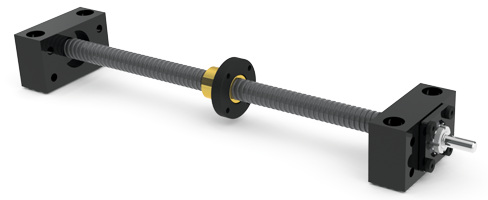
By Jon Kasberg, Regional Sales Manager, Nook Industries
Introduction
Of all the screws in industry used for motion, ball screws provide unique benefits when compared to other standards, such as roller screws or acme screws. A ball screw is a device comprised of a shaft and a nut where either of which can be the traversing component. Ball screws work similarly to ball bearings, where hardened steel balls move along an inclined?hardened inner and outer race. With at least 90 percent efficiency, ball screws are one of the most efficient ways of converting rotary motion into precision linear motion.
History
The history of the simple friction?based screw traces back to the days of Ancient Greece and Archimedes in the third century, B.C. Archimedes Screws were tools used to move water out of the hull of a ship. In 52 A.D. Heron of Alexandria considered the screw one of the five simple machines. In the 20th century, there was a need for replacing sliding friction with something more efficient, so in the 1940s, a division of General Motors called Saginaw Steering Gear developed a rolling friction screw, which used ball screw technology in automotive steering gears.
The basics
When it comes to ball screws, there is some key terminology to understand. The ball circle diameter is the diameter of the circle created by the center of the ball bearings when they come into contact with both the screw and nut. The root diameter is the minimum diameter of the screw measured at the bottommost point of the threads. Both diameters are important when calculating application characteristics and sizing parameters for factors such as column loading and critical speed.
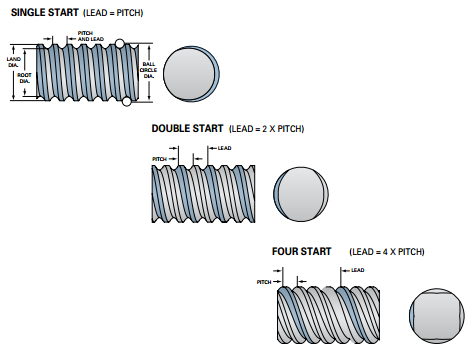
Pitch is the axial distance between two consecutive threads on a screw. Lead is the linear distance traveled by the nut or screw when either is rotated during one full rotation. The starts are the number of independent threads on the screw shaft. There are typically one, two or four starts on a screw, which resemble a helix that wraps around the shaft. The pitch multiplied by the number of starts equals the lead of the screw.
Lash is the result of the axial movement between a nut and screw without rotation. While lash can disrupt the accuracy of the screw, it is typically an occurrence that comes without any serious issues. Normal screws come with a relative amount of lash, and screws which are only loaded in one direction won't be affected by lash. Lash can be controlled through processes called preloading.
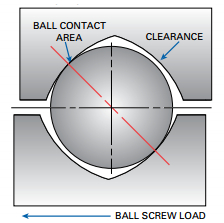
Preloading is the result of an internal force introduced between a ball nut and screw assembly that eliminates free axial and radial lash. There are three methods used for preloading. The double nut method uses two ball nuts that are loaded in opposing directions by a spacer, so that they don't wiggle when stationary. Lead shifting is a method where a shift or offset is manufactured in the lead of the ball nut. For example, a lead might be shifted from 5 millimeters to 5.05 millimeters in order to shift the ball bearings inside the ball nut in a different direction. This is the preferred method when considering compactness, but load capacity will be reduced. Ball selection is a low?cost method that involves using oversized ball bearings to create four points of contact between the nut and screw. This allows for a heavier load, but the friction from the contact can reduce the life of the bearings.
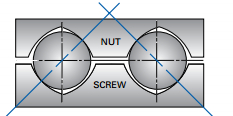
There are multiple types of loading considerations for ball nut screws. The static load (C0) condition is when the screw and nut are loaded to their capacity without damage. Metric screws with dynamic loading (Cn0) conditions are always given in Newtons for 1 million revolutions of life. Metric screws do not take the effect of the lead of the screw into life expectancy consideration. Inch/imperial screws do factor in the lead of the screw and have dynamic load ratings of 1 million inches of linear travel life. Because screws come in so many different sizes and are often tailored to industry standards, calculating these conditions can be tricky.
Life expectancy
Due to their steel?on?steel design, the bearing industry has developed ways to calculate the life expectancy of ball screws. However, other factors, such as contamination, lubrication and improper mounting and installation techniques, can also lessen the life of a ball screw. For manufacturers hoping to extend the life of their screws, it can be beneficial to order a larger size screw to handle a larger load, prolonging the life of the screw.
Life expectancy can be calculated using the following equations:
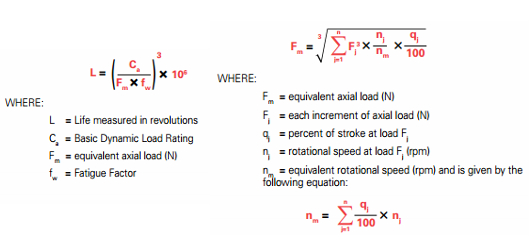
Instead of hand calculations, here are some charts to help calculate life expectancy:
Metric: www.nookindustries.com/LinearLibraryItem/Ballscrew_Life_Exp
Inch: www.nookindustries.com/LinearLibraryItem/Life_Expectancy__SRT_Rolled_Inch_Screws
Ball screws are known to encounter both compression and tensile loads. Compression loads tend to compress or squeeze the screw axially, which can make screws bow out. Tensile loads are those which tend to stretch the screw axially. While compression loading can be more problematic, tensile loading can cause the screw to elongate and crack. Knowing the direction the screw is loaded in as well as the end fixity helps when selecting screws as both critical speed and buckling need to be accounted for.
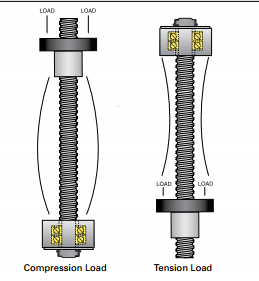
It's important to mention that screws are only meant for thrust loading, or straight line axial thrust motion. Any type of overturning loading or side loading can immediately reduce the life of the screw by up to 90 percent.
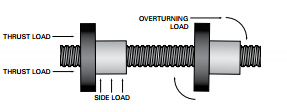
Typical ball nut types
The three most popular ball nut types are flanged, cylindrical body with key and v?thread. While the flanged configuration is integral to all ball nuts, the cylindrical body with key style is commonly used by actuator companies and OEMs.
All of the workings of the part are completely round, internal and generally fit most mechanisms in an actuator. The third type is the v?thread flange. V?threads are made custom to either be threaded into or be attached to a flange.

Application considerations
For the loading considerations of ball screws, it's important to remember backdriving. Backdriving is when a motor?driven screw will free fall once the motor shuts off, which is common for ball screws. To avoid this, companies will install brakes on the motors or use safety pins to lessen the risk and catch the load. Since acme screws are less efficient, this is less likely to occur with those types of screws.
There are a number of application accuracy requirements to consider with ball screws. Rolled screws are manufactured by round in a process by which metal bars are deformed by rotating dies. This process creates the helical thread pattern on a rolled screw. This is a more cost?effective manufacturing method, but typically produces a screw accuracy that is less than that of a ground screw. Some manufacturers do however produce highly accurate screws through a tightly controlled rolling process.
Ground screws are made from a grinding process by which a grinding wheel cuts the screw threads into case hardened material. As a result of this process, lead accuracies are typically much tighter than rolled screws. Ground screws are generally preferred over rolled in aerospace applications, because the seam that is formed close to the major diameter of the screw shaft has been thought to have potential for crack propagation.
Mounting considerations and end fixity
The end fixity of bearings pertains to how the screw is supported on both ends. Categories for end
bearings include free, simple, fixed and truly fixed. End bearings give the screw stability and rigidity. The fixity also impacts the column loading, critical speed and overall performance.
Speed and critical speed

Equations:
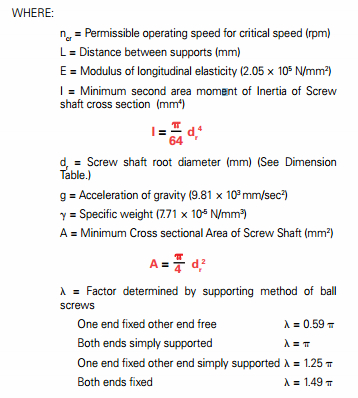

A: One end supported with a Double Bearing Mount and the other end Free (Use line A in charts)

B: One end supported with Double Bearing Mount and the other end with a Single Bearing Mount (Use line B in charts)

C: Both ends supported with a Double Bearing Mount (Use line C in charts)

D: Both ends supported with a Quad Bearing Mount (Use line D in charts)
Here are some charts to help calculate critical speed and column loading:
Metric: www.nookindustries.com/LinearLibraryItem/Ballscrew_Life_Exp
Inch: www.nookindustries.com/LinearLibraryItem/Critical_Speed__Ball_Inch_Screws
Column loading
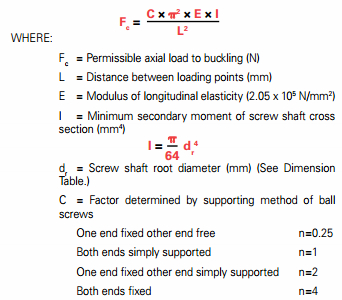
Metric: www.nookindustries.com/LinearLibraryItem/Col_Stren_w_EZM
Inch: www.nookindustries.com/LinearLibraryItem/Column_Strength__SRT__XPR_and_SGT_Inc h_Screws
Environment
Since ball screws often work in environments full of dirt and debris, manufacturers can take multiple precautions to keep out contamination and preserve the life of the screw. Often screws are coated with a thin dense chrome, black oxide or nickel?plated finish. Some manufacturers equip bellows boots that expand and contract like an accordion as the nut moves along to keep it covered from contamination. Bellows boots can be supplied in numerous materials so that they may be applied in even the most extreme applications. Another form of protection manufacturers uses are wipers. Nut wipers can be felted or plastic wipers that brush the nut free of any dirt or other contaminants and keep contaminants from entering the ball nut.
There's so much variance between different ball screw applications that there is no definitive answer for the amount of lubrication needed for each ball screw. However, considering factors such as frequency of use, temperature and viscosity are essential considerations for lubrication options. While a light oil or grease is suitable for most applications, the use of any lubricant containing molydisulfide or graphite should be avoided. A good rule of thumb is to always apply enough lubrication to maintain a thin film of lubricant between the nut and the screw.
Conclusion
While serving a great amount of applications, ball screws are perhaps best known for their capabilities in moving heavy loads at fast speeds with outstanding efficiency. In the long run, ball screw systems can prove to be a cost?effective alternative to pneumatic or hydraulic systems, which require constant electrical and air power.
Published March 2016
Rate this article
View our terms of use and privacy policy
